On November 9, 2013, I found myself stepping out of a hotel into the pitch black darkness of the night as I tried to find my way to a drugstore located just across the street. I was with ChinChin Chua, the owner of the hotel, and a few other people I didn’t really know. We were hoping to find some medicine for ailing people at the hotel. The drugstore had just been ransacked by looters. We barely found anything of use among the wet rubble on the ground. We were forced to leave quickly as a few men suddenly appeared from nowhere. They seemed to have been lurking in the dark.
It was the night after the Haiyan Typhoon, together with 15-foot-high waves from the sea, pummeled the city of Tacloban into heaps of debris. Shortly after the onslaught, the city had gone lawless and there was practically nowhere we could buy the essentials we needed to survive.
Those horrifying apocalyptic scenes you see on movies? … We experienced them in real life. And they offered many valuable lessons mankind can learn from.
The Need to Relay Information in Layman’s Term
On November 7, 2013, the day before Typhoon Yolanda made its landfall, Aaron Almadro had his parents and their housemaid checked in at a hotel located along Cancabato Bay. The ever doting son, he wanted to spare his parents the discomfort of waist-high floods that commonly inundated their home at the inland town of Palo on difficult weathers. This proved to be a fatal mistake, a mistake that could have easily been avoided had the responsible authorities communicated the dangers of the Yolanda Typhoon more effectively.
The dangers of Yolanda were not unforeseen. Two days before the storm, the International Federation of Red Cross and Red Crescent Societies was already sounding off worries about a “dangerous” typhoon headed for Leyte and Samar. The US Navy’s Joint Typhoon Warning System (JTWC) and the Philippine Atmospheric, Geophysical, and Astronomical Services Administration (PAG-ASA) did not fall short on their institutional mandate to issue tropical cyclone updates and warnings. Two days prior Yolanda’s landfall, PAGASA was sending out warnings of a 22-feet storm surge on an hourly basis. A 22-feet storm surge. People in Tacloban heard the warning, but failed to grasp its meaning. Had they called it a 22-feet tsunami-like wave, or something to that effect, people would have sought refuge in places far far away from coastal areas.
The irony isn’t lost on us. We are lucky to have cutting-edge technology like weather satellite systems to tell us beforehand that 22-foot-high waves are about to pound our city. We have gone past the days of old when people had to offer sacrifices to the gods and goddesses of the wind and storm if they were to have a semblance of control over the ever volatile weather. Truly a great accomplishment of mankind. It was bound to save lives, if only we’ve had the foresight to use simple terms to communicate the forecast. Mankind has managed to attain the unattainable, but failed on the simplest of tasks. The Philippines joined the 17th Congress of the World Meteorological Organization as they discussed the lessons offered by Typhoon Pablo and Typhoon Yolanda. One of the common lessons that sprang out of the discussion was the need to properly translate weather jargon. They acknowledged that the term storm surge was new, and had thus resulted to a lack of awareness and understanding. A lesson learned thousands of lost lives too late.
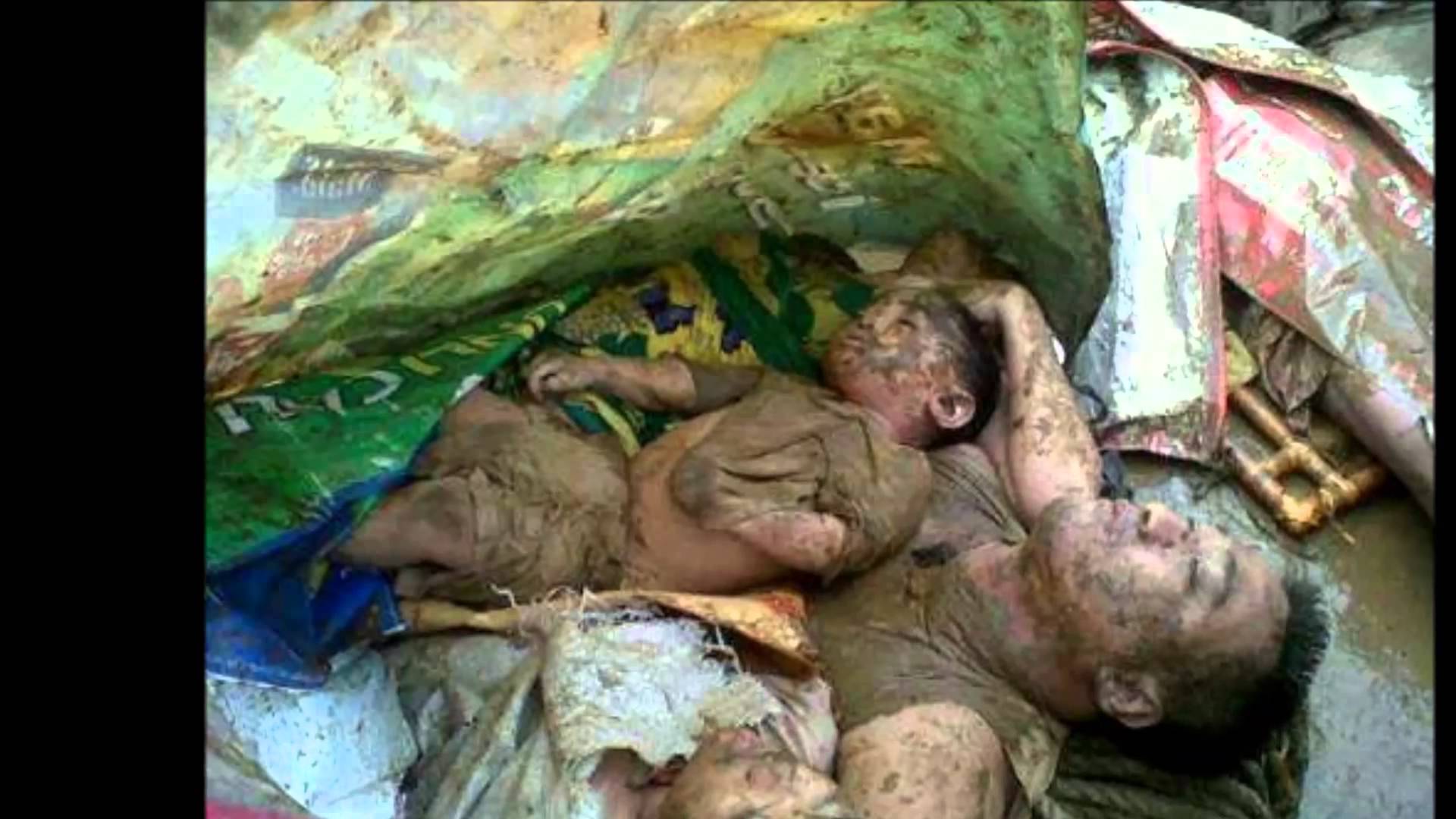
Aaron’s ancestral home in Palo was all but blown away. Together with his fiance and a friend with his wife and two-month-old baby, they endured the battering of Yolanda’s strong winds, and had to seek refuge under a huge shelf as the roof and walls of his home were either crushed or blown away piece by piece. It was a horrible episode that had them reeling with fear, but they were glad to have come out of it alive. Aaron’s parents weren’t as lucky. With the hotel facing the Cancabato Bay, there was no escaping the 15-foot-high waves that pummeled the city, reducing buildings and lives into heaps of debris. Had the elderly couple stayed at their ancestral home that was safely tucked farther inland, they would have survived. Many made the same fatal mistake.
The Dangers of Anarchy
Edward Gualberto, a village councilor and father of four, rummaged through debris in search of food, accidentally stepping on corpses scattered around, with flies swarming on them. “I am a decent person. But if you have not eaten in 3 days, you do shameful things to survive,” he said as he apologized for stealing from the dead. He further added, “We have no food, we need water and other things to survive. This typhoon has stripped us of our dignity… but I still have my family and I am thankful for that.”
Other survivors were more aggressive as they turned to stores for their loot. Some forced shops that had survived the typhoon open by breaking through steel barriers and hammering glass windows. One shop owner desperately brandished a gun as he tried to stop a mob from breaking into his shop. His efforts proved worthless as the mob ignored him and went on to ransack his shop. Emma Bermejo, the owner of a pastry shop nearby, lamented, “There is no security personnel, relief goods are too slow to arrive. People are dirty, hungry and thirsty. A few more days and they will begin to kill each other.”
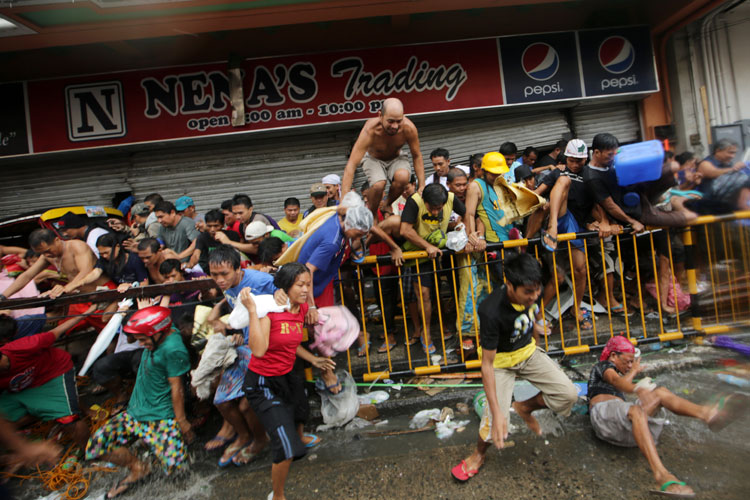
Antoinette, one of seven women who have managed to escape to the city of Cebu, looked back to five days without food or electricity or water. She recounted how they had to resort to looting. It was her two youngest daughters who carried out the deed, walking for three hours as they followed a crowd on its way to a warehouse. They bravely climbed up to the roof through a broken wall, going back down into the inside of a building filled with thieves. They were able to take rice, sardines, and water. Their mother was proud of their bravery. As for the girls, they said they were merely hungry.
In another warehouse, one housing NFA rice, eight people did not make it out alive as a wall collapsed, crushing and killing them instantly. Rex Estoperez, spokesman for the National Food Authority (NFA), claimed that “Some people are really hungry but others just wanted to ransack for money.”
As the pastry owner, Bermejo, said, “”This is shameful. We have been hit by a catastrophe and now our businesses are gone. Looted. I can understand if they take our food and water, they can have it. But TV sets? Washing machines?”
Nedy Tayag, a clinical psychologist for the health department who also worked with survivors of the Indian Ocean Tsunami of 2014 said that “Their reaction is normal in light of the abnormal situation,” that the behavior of Yolanda typhoon survivors was common among people who just suffered through catastrophes.
The regional health official, de Veyra, explained that the mental trauma caused by major catastrophes can affect a person’s everyday behavior and decision-making. “They are hoarding everything. These are psychological effects,” she said. A trained nurse, de Veyra’s disaster response experience includes working with survivors of the 2008 Typhoon Nagris in Myanmar, a catastrophe that left 138,000 people dead. “There is a justification: ‘I do not have anything but now I have the means to acquire them.’ It’s all about knowing that they are in control – they call the shots,” she added.
A 13-year-old boy, his toy car in tow, was walking along the debris-strewn streets of Tacloban when two strangers suddenly attacked him with a knife, leaving him with a stab wound on his stomach and a slit throat before disappearing without a trace.
Anarchy had pervaded the city. Talks of people breaking into homes to steal and rape women had also become rampant.
Tacloban officials urged Benigno Aquino III, the President of the Philippines, to declare a State of Emergency and if necessary Martial Law. Tacloban’s Vice Mayor Jerry Yaokasin explained that looting had become widespread and that such measures would help curb anarchy. The President responded by asking the city officials to first establish that there is threat of anarchy and violence and pass a resolution to that effect. Bureaucracy.
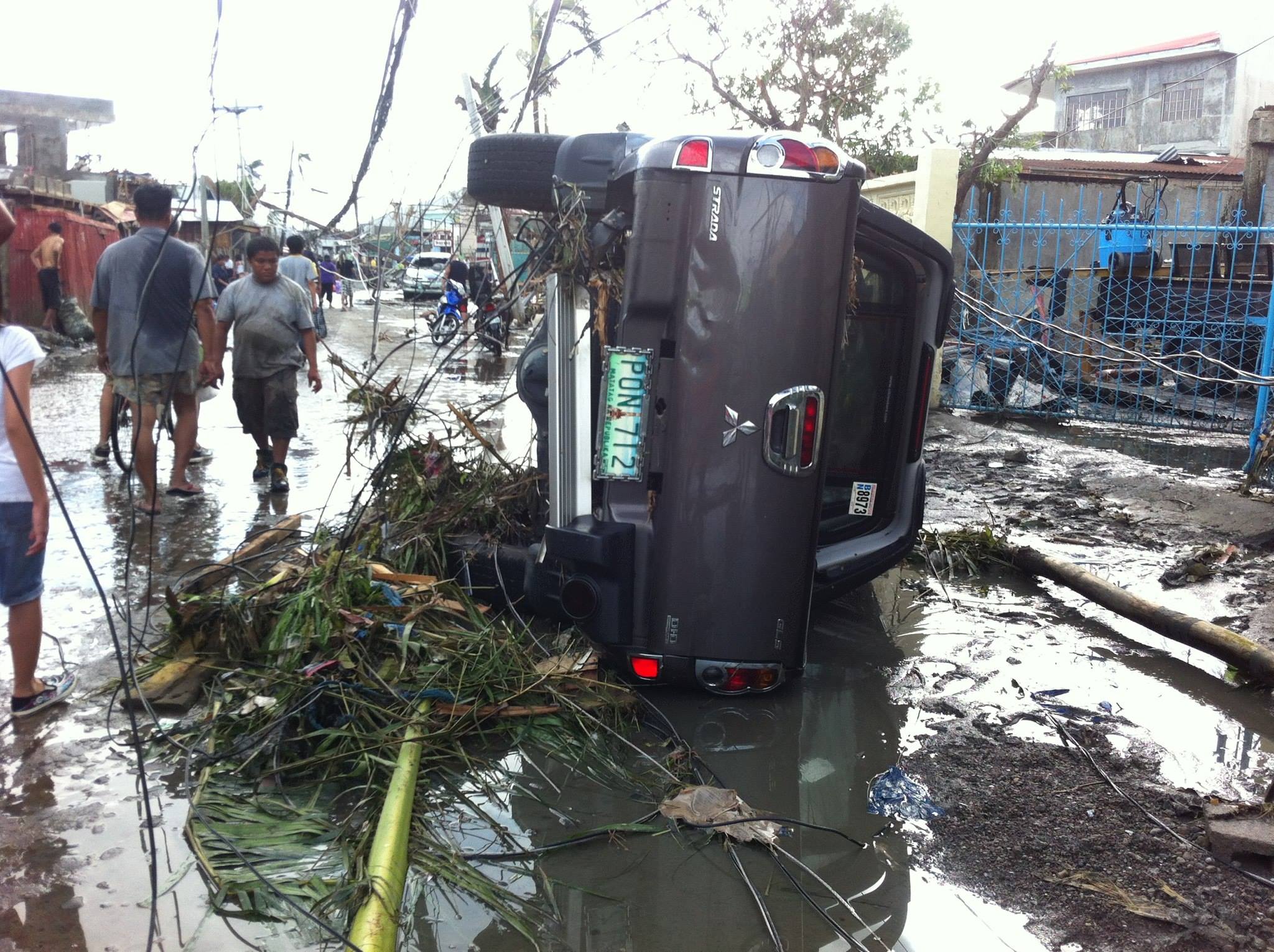
I was at La Rica Hotel, a seven-storey hotel located in the city center when Yolanda made its landfall. I was lucky to be in one of the, if not the highest, buildings in Tacloban. Located only a few meters from the sea, I watched as people clung to the roofs of nearby buildings, trying to escape the 15-foot-high waters. When the water had subsided, I stepped outside the building to witness the widespread looting already taking place. I later walked around the city and realized that there was now only one small grocery store and a sidewalk vendor selling food and other goods. All the major stores were eventually looted, wet goods notwithstanding. It was apparent that commerce had died, and that we were counting the days when we would soon run out of food and water.
The following day, we walked the long way home to V&G Subdivision, a suburban subdivision located farther inland. The storm surge did not reach the area, but the conditions were not that much better, with the same shortage of goods confronting the people. I came across a friend desperately scrambling for distilled water and milk for his one-year-old baby. “I would go rob people if I have to”, he said.
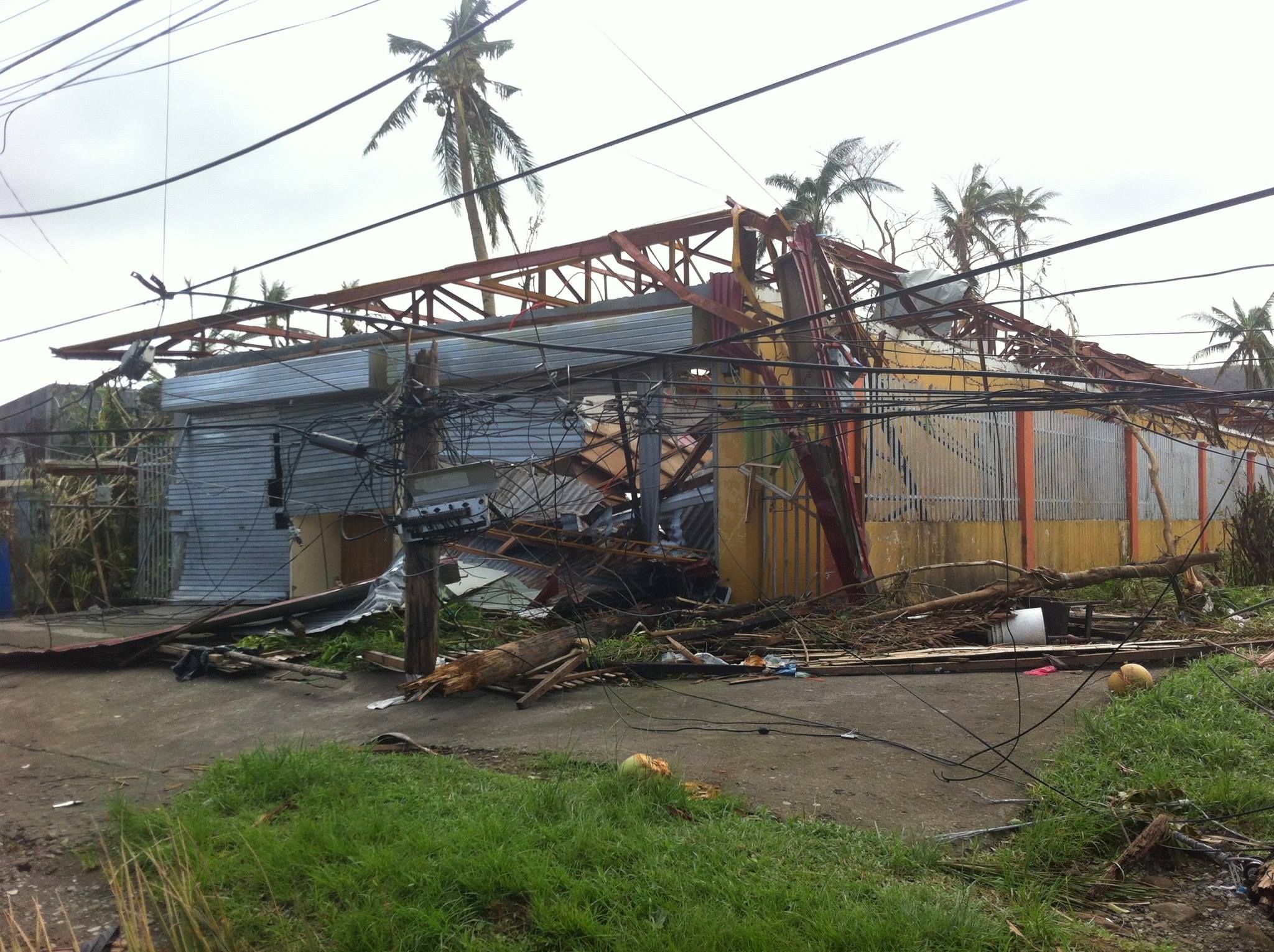
The Vital Role of the Government
Just hours after the monster typhoon battered our city, when the 15 feet high waters (or was it higher?) had ebbed away, I stepped out of the hotel to find a city that had gone lawless. Commerce had also died. It was clear that the people would soon have to rely on the government for sustenance.
Air Force Lieutenant Colonel Fermin Carangan, commander of the Philippine Air Force’s Tactical Operations Group 8, was at their headquarters located near Tacloban’s airport in San Jose when the monster typhoon Yolanda made its landfall. As Yolanda was starting to reveal its strength, the troops were also gearing up for possible rescue missions. Little did they know that they would need rescuing themselves. As the waters rose, they had to punch a hole through the ceiling. Carangan was last to climb up, but he was left to watch as his men were swept away by the sea. It especially pained him to watch two fresh graduates from the Philippine Military Academy (PMA) get swallowed by the water.
Carangan managed to hold onto a piece of wood as he himself was washed away by the waves and the current. For a long while, all he could see were the tips of coconut trees that were being obliterated by the unbelievably high waters, as he was swept farther away into the sea. Then he saw a child clinging to a floating coconut tree. He pulled the child and had him cling to the same piece of wood he was holding onto. They went through “another hell”, as strong winds swirled around and great big waves slapped them from all directions, forcing them to swallow lots of saltwater. Miguel had started to shiver from the cold, and they had both gotten too tired. But he held on, mostly for the young boy’s sake. He persisted as he tried to keep the child awake. Carangan believes that it is because of the young boy that he is still alive.
The local government officials were victims themselves. Mayor Alfred Romualdez and his family barely escaped the high waters, as they held onto the beams of a ceiling. The mayor ended up wearing a pair of shorts someone handed over to him. It was looted from a department store. Only a small percentage of the local police force was able to report back to work, with many still unaccounted for. The prepositioned relief goods have been washed away with the waters. It was clear that our local government had been disabled. We were at the mercy of the national government.
I was able to fly out to Manila three days after Yolanda made its landfall. All too aware of the dangers and desperation that continued to ravage Tacloban, I was determined to let the world know just how bad things were back home.
What I saw on TV and on social media horrified me though. We had a government that was bent on deflecting blame and downplaying the number of deaths and just how bad things were on ground zero. A number of people were taking the side of the national government and were castigating Taclobanons for being too demanding and ungrateful. A violent discourse around who was to blame – Aquino or Romualdez – had caught fire. An unnecessary maelstrom, to say the least!
A somber Anderson Cooper, who was on ground zero, said in an interview:
“It is a miserable miserable situation here and it does not seem to be getting better day by day. We are now entering the fifth day since the storm hit here in Tacloban …
… You would expect perhaps to see a feeding center that had been set up 5 days after the storm. We haven’t seen that, certainly not in this area. Some food is being brought to people here at the airport, some water being distributed but these are very, very difficult conditions for the people here on the ground and it’s not clear how much longer it can continue like this. Something’s got to give …
… People are desperate. People do not have any place for shelter. It’s very difficult for people to get food. It is a very desperate situation, among the most desperate I’ve seen in covering disasters in the last couple of years …
… the people in Tacloban have great dignity and deserve better than what they have gotten …
… As for who exactly is in charge of the Philippine side of this operation, that is not really clear.”
He also said in another interview:
“They have survived for a week now, often with very little food, with very little water, with very little medical attention. Can you imagine the strength it takes to be living in a shack, to be living, sleeping on the streets next to the body of your dead children? Can you imagine that strength? I can’t and I have seen that strength day in and day out in the Philippines and we honor them day in day out here in the Philippines, and we honor them with every broadcast that we make.”
Us Taclobanons wanted to be heard. We wanted people to know just how bad the situation was in Tacloban. We needed people to know just how desperately we needed help. Anderson Cooper instantly became our hero.
Not everybody was happy though. Korina Sanchez, one of the key media personalities in the Philippines, remarked over her DZMM radio program that CNN’s Anderson Cooper didn’t know what he was talking about. She happens to be the wife of Mar Roxas, the Department of the Interior and Local Government (DILG) Secretary and the key personality behind the national government’s Yolanda operations.
Eleven days after the storm, Mar Roxas had this to say, “The priority now is the recovery and possible identification of the cadavers still buried somewhere or among the rubbles left behind by Yolanda.”
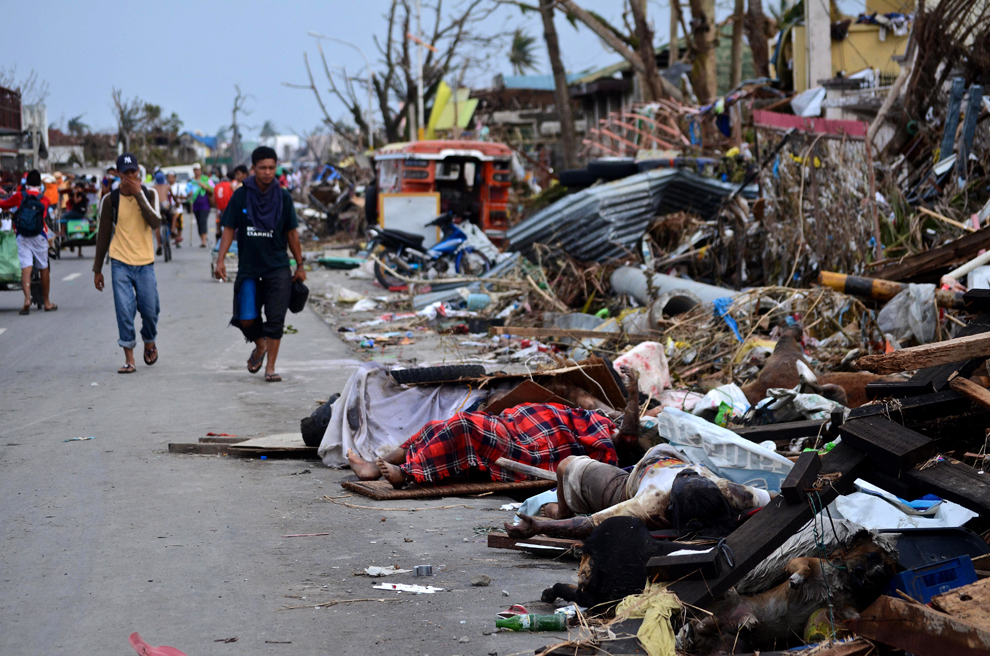
Patricia Evangelista, a journalist for Rappler who braved ground zero, painted a bleak picture,
“Even after assurances from the President and his men, even after Roxas announced on CNN he himself had joined the cadaver collection, the survivors continued to live with the uncollected dead. On the 12th day after the storm, a line of bodies, several inside trash bags, lay in a crooked line outside the Basper Public Cemetery. On the 15th day, a backpack sat on the side of the airport road, a baby inside. On the 16th day, the body of a young man floated face down beside the Paradise Village pier, feather strings of skin trailing in his wake, schools of fish chewing on what was left. On the 17th day, clumps of corpses floated beside sunken container trucks on the bay, their limbs tangled on wooden markers. On the 22nd day, village chiefs in San Jose reported at least a hundred uncollected bodies scattered along their coastlines. On the 23rd day after the storm, Navy men stationed along the city seaport said they did not have the equipment for the retrieval of headless cadavers caught in recesses beneath the pier.”
Irene, a medical representative living in Happy Homes Subdivision, had to fight through 15 feet high waters, swimming out the window and pulling her three small children one by one. They hung on to what little remained of her gutter roof, until another black, massive wave plummeted them once again. The next thing she could recall was waking up 15 feet from the ground, hanging from a light post. Arms covered with gashes, she made her way down and was greeted by a commotion, as neighbors frantically pumped the water out of one of her sons. He did not make it. She later found her two other children a kilometer away. They did not make it either.
Irene spent the following days on the sidewalk, watching over her dead children. She wanted to make sure they got proper burial. On the third day, with the help of her neighbors, she carried her children to a nearby cemetery, and watched as her little angels were wrapped in plastic, tied with rope, and buried at an open space.
For days, she did not eat nor sleep. She did drink coffee though, mixed in cups of boiled salt water. She testifies that no matter what the government says, the truth remains – there was no food in her village for five days.
Social Contract Theory and the State of Nature
Thinkers like Thomas Hobbes, John Locke and Jean-Jacques Rousseau were wont to paint a picture of a hypothetical stateless society, or what they called a ‘State of Nature’. State of Nature refers to a society devoid of political authority and of legal checks or constraints on the individual. They used the term or the image as a theoretical device to portray society as it would be in the absence of regulatory institutions like the government, pointing to how unconstrained freedoms would lead to a life that is ‘solitary, poor, nasty, brutish and short’ (Hobbes). They then pointed to the ‘Social Contract Theory’, or the contention that individuals, in their quest for self-preservation, voluntarily enter a ‘Social Contract’ as they escape the dangers of the State of Nature. Bound by the Social Contract, people subject themselves to the power of the state, meeting their own obligations as citizens and following established rules and laws. They relinquish absolute freedom in exchange for the security and stability that a system of political rule can provide. Their limited freedom essentially ensures that they are protected from the caprices of their fellow human beings who are also bound by the same limited freedom. It is therefore believed that without a state … people, motivated by survival and self-preservation, tend to exploit, abuse and enslave one another. As Locke would put it, “Where there is no law, there is no freedom’. It is through the Social Contract Theory and the theoretical State of Nature that the thinkers of old examined the grounds of ‘Political Obligation’, or the citizens’ duty towards the state, providing basis for the state’s right to rule.
After the apocalyptic typhoon Yolanda pummeled the city of Tacloban and its surrounding towns, people of Leyte and Samar experienced first-hand what it’s like to be in a ‘State of Nature’.
As citizens who have always striven to meet our own end of the Social Contract, meeting our obligations as we religiously pay our taxes and follow the rules and the laws as best we could, the people of Leyte and Samar expected the government to meet their end of the bargain. The government had a sworn duty and the innate obligation to protect our integrity and preserve our lives. From how we see it, they failed as an institution. They even failed as human beings expected to treat their fellow human beings with compassion.
In a council meeting held shortly after the typhoon, a Taclobanon businessman asked President Aquino to declare martial law or at least a state of emergency, explaining the urgency of the situation as he recounted how he was held at gunpoint by looters. The Philippine president callously replied, “But you did not die, right?”.
During the whole Yolanda episode, we were confronted with the stark reality that whoever was sitting on the throne could mean the difference between life and death for some people.
You can read more about my Yolanda experience here: Tahna de Veyra’s Survivor Story.
Author: Tahna de Veyra
Voracious eater. Coffee dependent. Book sniffer. Music addict. Profound thinker. Certified ambivert. Life-hungry maverick. Nonchalant realist. Hesitant blogger.

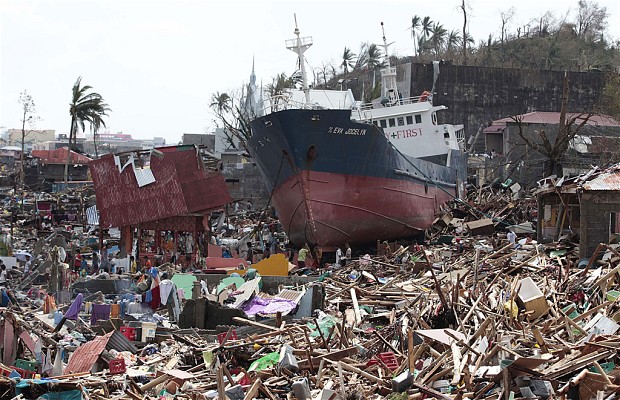
Wow this is truly horrifying to read. I feel for all these people. This was so hard to read. So much needs to be learned from this tragedy in order to be better prepared in the future. I hope and pray that his never happens again.
I feel very emotional after reading about what happened to people affected by this catastrophe. So many lives lost and people hurt. Hopefully the government will be better prepared in the future to handle such events.
Wow! This is just awful and I really am speechless. I hope that plans are pur in place so this never has to happen again x
The point you make on people getting tendencies to kill and loot is well supported by what hardships they go through. Human suffering is sad, but when faced with issues surrounding lack of resources in a tragic event, it makes it even more sad. We faced that situation briefly here in Chennai in 2004 during the Boxing Day Tsunami. There was a lot of public help from private people pouring in to help more than the governments. I notice that as weather patterns hit india, a lot of indians take personal time out to visit places for relief and help. I hope to see if I can do my bit in such activities.